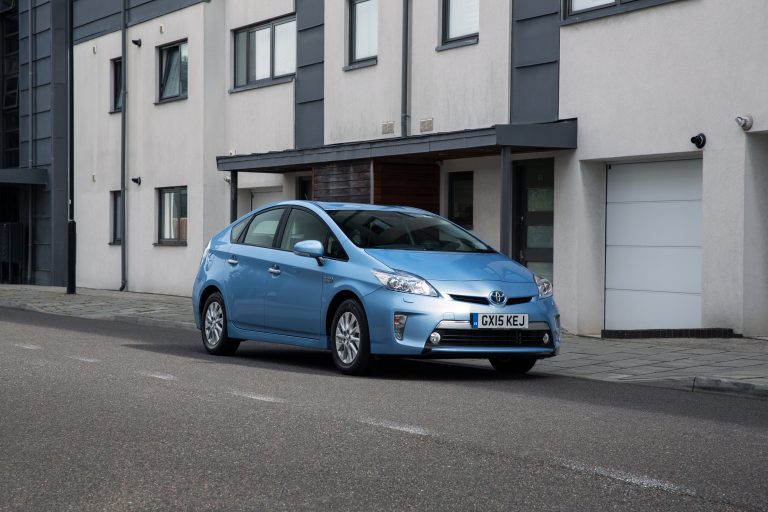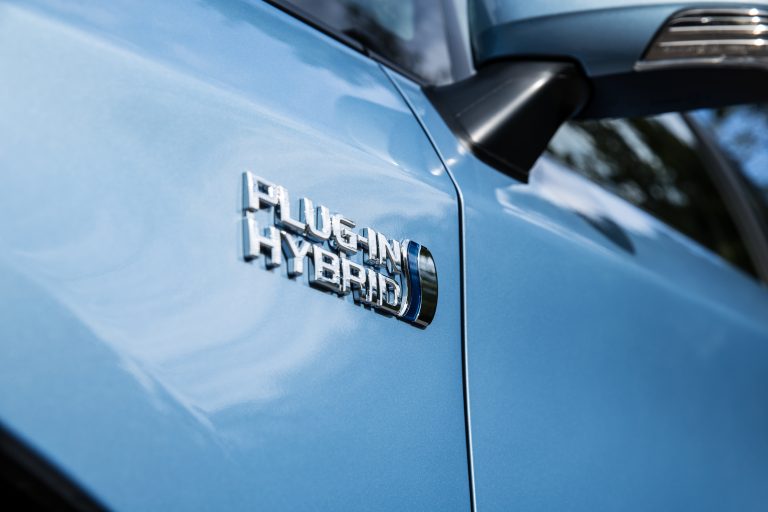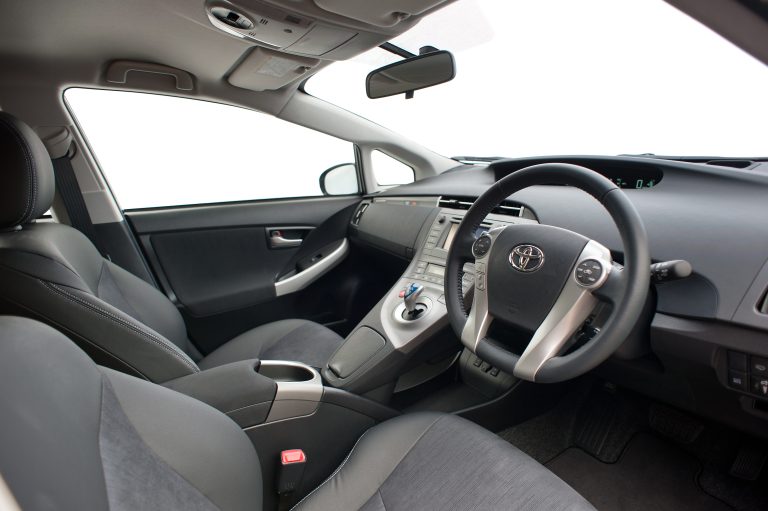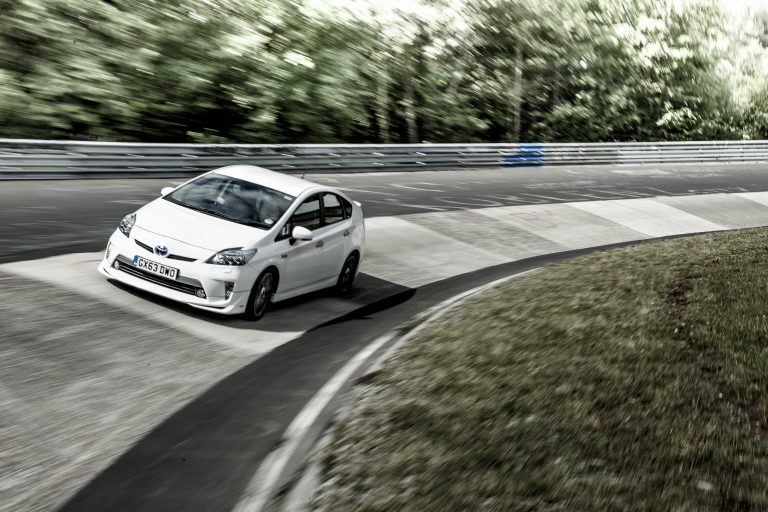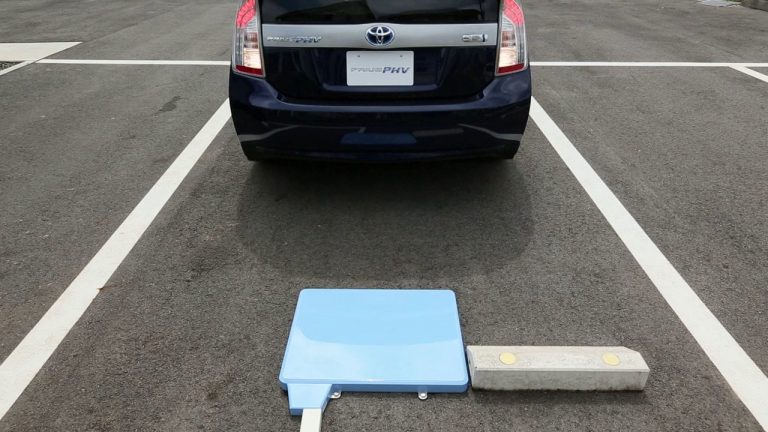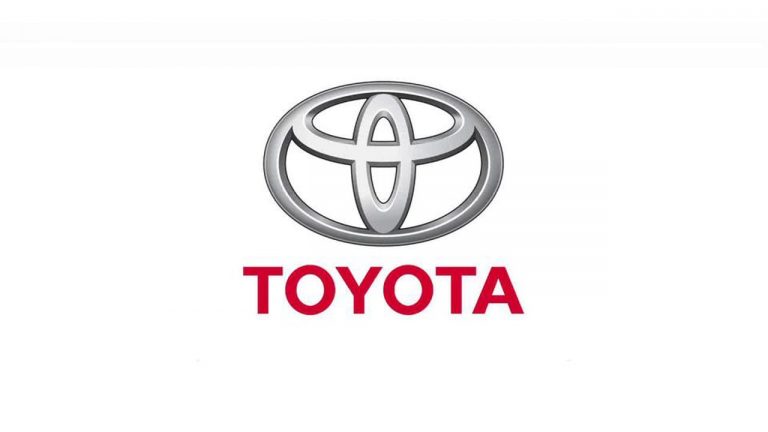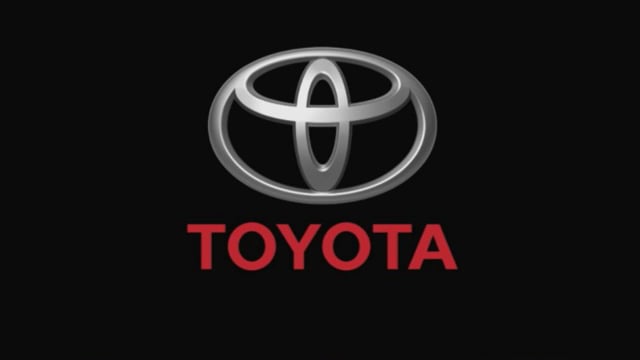Toyota and EDF Energy launch Prius Plug-in Hybrid lease demonstration programme
- 20 Prius Plug-in Hybrid cars take to London’s streets from July 2010
- Three-year lease demonstration programme providing plug-in hybrid vehicles to public organisations and business fleet users
- Data collection to provide Toyota, EDF Energy and UK Government with real-world intelligence on user behaviour and attitudes, vehicle performance and energy recharging and infrastructure issues
- Rechargeable lithium-ion battery gives Prius Plug-in extended electric-only driving range for zero fuel consumption, zero tailpipe emissions performance
- Combined cycle fuel consumption 108.6mpg and 59g/km CO2*
- EDF Energy delivering charging points for programme, at workplaces, on-street and domestic locations
- One of eight projects in the Technology Strategy Board’s national Ultra Low Carbon Vehicle Demonstrator Programme, part-funded through the Office for Low Emission Vehicles (OLEV) and administered by Cenex
- Programme paves the way for commercialisation of Prius Plug-in
A new type of cleaner vehicle for sustainable mobility
A new kind of Toyota Prius makes its debut on London’s streets this summer. A joint programme between Toyota and EDF Energy is leasing 20 Prius Plug-in Hybrids for use in fleets operated by public organisations and businesses in the capital.
The real-world experiences of the drivers and fleet operators will provide both companies and UK Government with valuable insights into driver attitudes and usage patterns to help them shape their strategies for introducing plug-in hybrids and recharging technologies. It will also help inform and shape public policy in this field. Thanks to EDF Energy’s recharging infrastructure, which will be installed at workplaces, on-street and in domestic locations, and further data logging by the vehicle operators and Toyota, the programme will deliver valuable intelligence about the benefits gained in energy savings and reduced emissions, public perceptions and recharging patterns and preferences.
The cars involved in the lease programme are essentially the same as the current third-generation full hybrid Prius, but they are equipped with a powerful lithium-ion battery. EDF Energy has identified appropriate plug, socket, wiring and cabling specifications to comply with BS7671, while maintaining fundamental ease of use. The charging points incorporate a keypad that enables each user and vehicle to be identified when recharging takes place.
The advanced rechargeable battery technology gives Prius Plug-in extended capabilities when it is driven in EV (electric vehicle) mode: capable of running for up to 12.5 miles solely on its electric motor – battery charge and road conditions permitting – at speeds up to 62mph, it can accomplish the great majority of typical urban journeys with zero petrol consumption and tailpipe emissions. Should the battery charge be used up in the course of a journey, Prius Plug-in will seamlessly switch to power from its 1.8-litre VVT-i petrol engine, meaning the driver need suffer no “range anxiety” about the distance his or her car might manage.
As part of a worldwide initiative involving 600 Prius Plug-in, 200 of which are in Europe, the London programme will support Toyota’s plans to introduce a plug-in hybrid vehicle (PHV) to the market.
EDF Group has 50 years’ experience in the field of electric vehicles and in Britain, EDF Energy is the largest generator of low carbon electricity. It is providing charging points for all the vehicle operators participating in the programme, and will be working with the vehicle operators to understand how best to achieve carbon savings. The development of a comprehensive, accessible and reliable charging infrastructure is a prerequisite of any successful plan for widespread electric vehicle take-up by motorists and fleet operators.
The leasing programme benefits from funding support from the UK Government, via the Technology Strategy Board’s Ultra Low Carbon Vehicle Demonstrator Programme, a trial part funded through the Office for Low Emission Vehicles (OLEV). This programme is bringing more than 340 innovative vehicles on to Britain’s roads in locations around the country.
As a venue for the UK leasing programme, London has a well-advanced strategy for low carbon transport. The city has a delivery plan for 25,000 Electric Vehicle charging points (public and private) to be in place by 2015.
The programme has been warmly welcomed by London’s Transport Commissioner, Peter Hendy, who said: “The delivery of the new Toyota Prius Plug-in takes us another step closer towards making London the electric vehicle capital of Europe.”
The partners in the leasing programme that will be running the Prius Plug-in in their vehicle fleets are Transport for London, the Government Car and Despatch Agency, the Metropolitan Police Service, News International and Sky.
TOYOTA PRIUS PLUG-IN
- Plug-in hybrid technology, a significant expansion of Toyota Hybrid Synergy Drive
- Extended, 12.5-mile driving range in EV (electric vehicle) mode with zero CO2, NOx and particulate emissions
- 108.6mpg combined cycle fuel consumption and 59g/km CO2 emissions*, 30 per cent lower than current Prius
- First use of lithium-ion batteries in a full hybrid Toyota vehicle
PHV technology
The new Prius Plug-in Hybrid vehicle represents a significant expansion of the capabilities of Toyota’s Hybrid Synergy Drive system.
Building on the core technology of Toyota’s full hybrid powertrain, as deployed in the third-generation Prius and the new Auris Hybrid, it addresses the specific needs of people living in urban areas by delivering lower emissions, improved fuel economy and a much greater range and higher speeds in fully electric EV driving. At the same time, the presence of the petrol engine in the hybrid powertrain means that Prius Plug-in is equally able to tackle longer journeys without compromise or anxiety about the range available.
Hybrid Synergy Drive gives impressive, seamless acceleration through an electric continuously variable transmission (CVT), returning unmatched fuel efficiency and low emissions.
Performance
Total system output from the Hybrid Synergy Drive powertrain is 134bhp, enabling nought to 62mph acceleration in 13.7 seconds and a 112mph top speed.
Thanks to its ability to run further in EV mode, it achieves exceptional combined cycle fuel efficiency, with an official 108.6mpg and CO2 emissions of 59g/km*, figures that are a 30 per cent improvement on the standard, third-generation Prius.
Prius Plug-in’s environmental performance is further strengthened by the fact that, compared to diesel cars, it emits much less NOx and no particulates. And when running on its electric motor alone – in EV mode – it produces no CO2 or NOx, driving up to 12.5 miles at speeds up to 62mph, according to the level of battery charge and road conditions.
Prius Plug-in with Hybrid Synergy Drive
Thanks to its ability to run further in EV mode, it achieves exceptional combined cycle fuel efficiency, with an official 108.6mpg and CO2 emissions of 59g/km*, figures that are a 30 per cent improvement on the standard, third-generation Prius.
Its Hybrid Synergy Drive powertrain comprises:
- A 1.8-litre VVT-i petrol engine
- A compact but powerful electric motor
- A power split device that uses a planetary gear set to automatically combine and reallocate power from the engine, electric motor and generator as required
Seamless acceleration is delivered by the electric continuously variable transmission (CVT), controlled by shift-by-wire technology. The result is a highly efficient, smooth, yet responsive performance.
The electric motor is powered by a lithium-ion battery (details below) and works in tandem with the petrol engine to boost acceleration during normal driving. The system constantly adjusts the power allocation between the engine and electric motor to achieve the best possible balance between performance and efficiency.
In EV mode the electric motor alone powers the driven (front) wheels. According to the level of battery charge and driving conditions, Prius Plug-in can be driven in this mode for up to 12.5 miles, and up to a maximum 62mph. However, once the battery charge has been used up, the car automatically switches to full hybrid operation, until recharged from an external power supply. This means there are none of the limits on driving range that are associated with conventional, all-electric vehicles.
The Hybrid Synergy Drive system’s efficiency is boosted further by the electric motor’s ability to work as a high-output generator when the car is slowing down or under braking. This regenerative braking captures kinetic energy that would normally be lost as heat and store it as electric energy in the high-performance lithium-ion battery.
Lithium-ion battery – a first for Toyota
The new Prius Plug-in marks the introduction of lithium-ion batteries in a Toyota hybrid. This technology has been chosen for two key reasons:
- It offers superior volume energy density compared to the nickel-metal hydride type (as used in the standard Prius), which means a greater EV driving range can be achieved without too great a penalty in weight or packaging
- It can be recharged more quickly than a nickel-metal hydride battery
Two thirds of the battery pack must be recharged by connecting it to an external, plug-in electricity supply, while the other third is integrated into the vehicle’s full hybrid drive system and so is constantly recharged as the car is driven
day-to-day.
The battery pack can be recharged simply by plugging the detachable cable into the charge point socket. A full recharge takes about one-and-half hours from a regular 230V power supply.
Eco driving experience
Prius Plug-in automatically operates in EV mode from start-up and at speeds less than 62mph, using its electric power alone and giving an exceptionally smooth and quiet ride.
This capability requires full hybrid power, as delivered by Toyota’s Hybrid Synergy Drive system; it is not available to drivers of “mild” hybrid vehicles.
As well as standard EV mode, the driver can also select ECO and POWER modes on-demand to further increase efficiency and fuel economy, or performance.
In ECO mode, throttle response to aggressive accelerator inputs is reduced and air conditioning operation is adjusted to support better fuel economy. According to driving conditions, this can bring a perceptible saving in fuel consumption.
POWER mode modifies response to throttle inputs by up to 25 per cent, boosting power to improve acceleration and increase driving pleasure.
Driving support monitors
Prius Plug-in provides plenty of support to help motorists tailor their driving techniques to achieve the most environmentally efficient results. The Eco Drive Monitor, already fitted to the standard Prius, has been revised to help owners maximise the added benefits of Prius Plug-in’s extended EV driving range.
The Hybrid System Indicator dial shows the point at which the petrol engine will kick in when accelerating, helping the driver moderate throttle inputs and maximise use of the EV mode.
The Energy Monitor, which shows in real time the engine’s operating conditions and the flow of power around the system, incorporates an EV driving range display. This shows how far the car can be driven under electric motor power with the remaining battery charge.
The EV Driving Ratio Indicator shows the total distance driven solely under electric motor power.
Together these functions can help drivers adopt relaxed, fuel-efficient driving techniques, maximising the car’s performance efficiency.
Special features
Thanks to the fact Prius Plug-in can access electricity from an external source, a remote climate control system has been developed, unique to the model.
This pre-air conditioning function allows the car to be cooled or warmed up while it is plugged in for recharging, providing driver and passengers with a comfortable cabin temperature from the moment they get on board. This improves the vehicle’s overall efficiency and fuel economy, as it means less energy is used by the air conditioning system during start-up.
The dashboard includes a graphic display of a growing forest, which lets occupants see in real terms the benefits in CO2 reduction delivered by battery charging. The image is based on the amount of CO2 absorbed by a tree over a year. While the vehicle is plugged in, the system calculates the reduction in CO2 emissions by using an external power source and determines the equivalent number of trees, which “grow” one by one on the display into a forest representing the emissions saved.
Prius Plug-in with Hybrid Synergy Drive
TOYOTA AND FUTURE POWERTRAIN TECHNOLOGY
- Toyota a world leader in the development of sustainable mobility
- Prius Plug-in Hybrid paves the way for more diverse applications of Hybrid Synergy Drive and new eco-car concepts
- Advances in battery technology and charging and fuelling
- infrastructures fundamental to development of Electric Vehicles (EVs) and Fuel Cell Hybrid Vehicles (FCHVs)
- EV technology to deliver sustainable mobility in the short to medium term
- Hydrogen fuel cell technology has potential to change the face of motoring forever
Toyota’s quest for sustainable mobility
Although the reduction of CO2 emissions didn’t become a mainstream global issue until the 1990s, Toyota has been researching and developing mobility solutions that are kinder to the environment for more than 40 years in its quest to create the ultimate eco-car.
After addressing the possibilities of different types of hybrid systems, Toyota focused its efforts on creating mass-production hybrid vehicles suitable for the mass-market.
This early vision has been fully vindicated. Prius, the world’s first mass-produced full hybrid vehicle, was launched in Japan in 1997 and in Europe three years later. Its unique Hybrid Synergy Drive powertrain established a major industry milestone in sustainable mobility. Today, while other manufacturers are only beginning to develop hybrid technology, Toyota has already moved on to the third generation of its multi-award-winning Prius.
Moreover, the introduction this summer of the British-built Auris Hybrid signals much wider application of Hybrid Synergy Drive and prefaces the introduction of up to 10 new Toyota hybrid models in the next few years with the aim of one million annual hybrid vehicle sales worldwide.
Toyota has already sold 2.5 million hybrids globally, which is 80 per cent of all hybrid sales. This has contributed to a reduction in automotive CO2 emissions of about
12 million tonnes, giving the company an unquestionable lead in the drive towards sustainable mobility.
Modular Hybrid Synergy Drive as a core technology
Although Toyota positions Hybrid Synergy Drive as its core technology platform for the future, it believes it is important to follow more than one path in its development of more environmentally efficient mobility.
To support this, Hybrid Synergy Drive has been designed to be modular and adaptable to work with different energy sources. This means it can readily be used in Plug-in Hybrid Vehicles (PHVs), Electric Vehicles (EVs) and Fuel Cell Hybrid Vehicles (FCHVs).
Benefits of plug-in hybrid technology
Seventy per cent of Europeans are expected to live in urban areas by 2015, bringing with it greater demand for short-distance commuter vehicles that are kinder to the environment. To meet this demand, the motor industry is focusing on electricity as a power solution.
To support this, Hybrid Synergy Drive has been designed to be modular and adaptable to work with different energy sources. This means it can readily be used in Plug-in Hybrid Vehicles (PHVs), Electric Vehicles (EVs) and Fuel Cell Hybrid Vehicles (FCHVs).
Electricity has great potential as an alternative to oil: it can be produced from sustainable sources; it can be readily supplied; and it is carbon neutral at the point of consumption. In this context, the environmental merits of EVs as urban commuter transport are well proven and their future in providing sustainable mobility is assured.
But the further development of these vehicles is constrained by the weight, size and cost of the large-capacity batteries required if the vehicles are to offer a satisfactory driving range, and by the absence of an adequate charging infrastructure.
Toyota has addressed both these issues in its development of PHV technology. Prius Plug-in is a full hybrid vehicle in which both the electric motor and petrol engine can drive the wheels. For city driving it operates in a fully electric EV mode, while the hybrid system’s petrol engine means the car has true long-range capability, too.
Prius Plug-in and Hybrid Synergy Drive
Toyota’s new Prius Plug-in Hybrid represents a further application of Hybrid Synergy Drive, the core technology in its quest to achieve sustainable mobility. In this way it is not a replacement for the standard, full hybrid Prius: Toyota expects both models to co-exist alongside each other as markets for these technologies develop. Prius Plug-in Hybrid will target the most environmentally conscious urban motorists.
Hybrid Synergy Drive, the powertrain at the heart of Prius, Prius Plug-in and the new Auris Hybrid, is readily adaptable for other uses, including Electric Vehicles (EVs) and Fuel Cell Hybrid Vehicles (FCHVs). But making these technologies viable for mass production depends on a series of key factors: a significant advance in battery technology; the setting up of comprehensive recharging and refuelling infrastructures; the achievement of competitive market pricing; a supportive public policy environment; and consumer acceptance of the technology.
Toyota Optimal Drive
As well as the research and development of cleaner, more efficient future powertrain technologies, Toyota continues to deliver improved performance from its current range of conventional petrol and diesel engines and its manual, automatic and continuously variable transmissions. Through the application of Toyota Optimal Drive technologies, including the use of lightweight components, reduced friction and functions such as engine stop-start (on selected models), all new Toyota cars are achieving significantly greater fuel efficiency, lower emissions and stronger performance.
Since the introduction of the first Toyota Optimal Drive powertrains in 2008, the average CO2 emissions of Toyota’s UK fleet has fallen to a market-leading 124.55g/km, according to independent research by Clean Green Cars. This is already well below the European Union’s target figure of 130g/km set for 2012 and 20g/km lower the than the UK market average.
EV technology
Toyota has built up a great depth of knowledge and engineering capability in the field of EVs. Ten years ago it ran a three-year test programme in which around 1,900 electric battery powered RAV4 compact SUVs were sold or leased. Each vehicle had a driving range of around 100 miles and almost half are still on the road today.
Even with that range, an EV cannot deliver the freedom of mobility most customers expect from their primary means of transport. And market acceptance of the electric battery concept is further hindered by the absence of comprehensive recharging facilities.
Nonetheless, thanks to advances in battery technology and the co-operation of governments, organisations and businesses in the development of a charging infrastructure, Toyota believes these obstacles can be overcome. And to that end, it has continued to develop short-range EVs with a view to commercialisation.
At the 2009 Tokyo motor show, Toyota unveiled the FT-EV II concept, a small commuter EV with a 62mph top speed and a driving range of more than 56 miles. This paves the way for Toyota to launch a lithium-ion battery-equipped EV in the USA by 2012.
Battery technology
The battery is a key element in hybrid power technology and in the 13 years since the first Prius was launched great advances have been made in reducing weight, size and cost, while at the same time improving efficiency.
Challenges remain, not least the need to significantly reduce the cost of lithium-ion batteries. Toyota is committed to developing new solutions and in June 2008 set up its own battery research department where it has been developing in-house technology since the early 1990s.
Subsequently a joint venture partnership was established with Panasonic EV Energy (PEVE), which will have an annual production capacity of 1.1 million battery packs by September this year.
Toyota has established unparalleled industry experience in the successful application of nickel-metal hydride batteries. It remains a robust, cost-effective and environmentally efficient solution in the context of the Hybrid Synergy Drive powertrain featured in Prius, new Auris Hybrid and other Toyota and Lexus full hybrid models marketed around the world.
Fuel cell technology
Fuel Cell Hybrid Vehicles potentially offer lasting solutions to the environmental and energy problems associated with motoring and they are considered by many to represent the ultimate eco-car – one that has potential for zero impact on the environment.
Fuel cells produce electricity through a chemical reaction between hydrogen (stored in the vehicle) and oxygen (from the air), with the only emission from the process being water vapour.
A fuel cell can convert as much as 80 per cent of hydrogen’s energy into usable power, which is about double the efficiency of a modern petrol engine.
Toyota began working on Fuel Cell Hybrid Vehicles (FCHVs) in 1992, applying its Hybrid Synergy Drive technology to vehicle development, replacing petrol engines with fuel cells and conventional fuel tanks with high pressure hydrogen storage.
Its latest model, the FCHV-adv, was given official vehicle-type certification in Japan in 2008. It can be driven for more than 500 miles on a single tank of hydrogen, with no other tailpipe emissions other than water vapour.
Although the vehicle itself produces no CO2, consideration has to be given to the carbon output from the hydrogen production process in order to gain an accurate well-to-wheel appraisal of the FCHV’s energy efficiency and environmental impact.
A smooth transition to a hydrogen-based society will be a significant undertaking. A consensus will need to be reached on the best means of producing hydrogen, how to deliver it and how to set up a fuelling infrastructure. Governments and all areas of society will need to focus and combine their efforts to ensure success.
To help promote this, and anticipating the commercialisation of a number of FCHVs, Toyota has joined Ford, Daimler, General Motors, Honda, Hyundai-Kia and Renault-Nissan in signing a letter of understanding in September 2009 calling for oil and energy companies and government organisations to co-operate in setting up hydrogen infrastructure networks of sufficient density in Europe, Japan, Korea and the United States by 2015.
This year Toyota launched a three-year FCHV programme, using 120 vehicles around the world to demonstrate the technology’s performance, reliability and everyday practicality. It has also joined the Clean Energy Partnership, an organisation which supports the development of fuel cell technology and hydrogen supply infrastructure in Germany. Toyota will be contributing five FCHV-adv to the programme by 2011.
Toyota’s goal is to introduce FCHV technology on the market in 2015.
EDF ENERGY
- One of Britain’s leading energy companies
- A wholly owned subsidiary of EDF Group which has 50 years’ experience in electric vehicle testing and operation
- Britain’s largest generator of low carbon electricity
- Committed to the development of low carbon mobility solutions
- Industry reference point for the design of vehicle recharging points and recharging infrastructures
Introduction
EDF Energy is a wholly owned subsidiary of EDF Group, a vertically integrated business covering power generation, distribution and supply in the UK.
EDF Group is the world’s leading operator of nuclear power stations. It is one of Europe’s largest power companies and, through EDF Energy, the largest generator of low carbon electricity in Britain. Around the world EDF Group has 38 million customers and employs 161,000 people.
EDF Energy key facts
- Its mission – “bringing affordable, low carbon energy solutions home to everyone”
- Generates around one fifth of Britain’s power
- Is the largest generator of low carbon electricity in Britain
- Owns 10 power stations
- Employs around 20,000 people in the UK
- Is the largest electricity network operator, distributing electricity to around a quarter of Britain’s population
- Supplies gas and electricity to more than five million domestic and business customers
EDF Energy’s Sustainability Commitments
EDF Energy has placed sustainability at the heart of its business model. In the knowledge that Britain needs secure and affordable energy to prosper, but without the carbon dioxide emissions, it has committed itself to change the way it does business.
EDF Energy has recently launched its new Sustainability Commitments, enhancing its previous Social and Climate Commitments. Revised and strengthened, they represent one of the biggest social and environmental programmes announced by any UK energy company. EDF Energy will lead the energy change by bringing affordable, low carbon energy solutions home to everyone.
Electricity production
In 2007, we pledged to reduce the carbon intensity of our emissions from our electricity production by 60 per cent by 2020.
We will now go beyond our original commitment by reducing the carbon intensity of our emissions to no more than 250g/kWh by 2020. This is more than a 60 per cent reduction on the 2006 baseline.
We firmly believe that nuclear power is the most affordable low-carbon option available and has a major role to play in the UK’s future energy mix.
Extending the life of existing nuclear power stations makes good economic sense and keeps carbon emissions down now. Investing in new nuclear helps secure low-carbon energy in future. With British Energy now part of EDF Energy, we believe we have created the platform on which we can justifiably lead the way in nuclear power generation in the UK. With 58 nuclear reactors in France and a total of 82 reactors operated across the world, EDF is by far the leading global nuclear power operator. This means we have unparalleled experience in building and running nuclear power stations from construction and operation, through to decommissioning and waste disposal.
We aim to invest in up to four new plants in the UK with a total capacity of more than 6,000 Megawatts (MW), with the first one planned to be operational in 2018.
Additionally, we will continue to invest in improving the efficiency of our coal-fired power plants to help reduce their carbon emissions, and to be involved in working towards the development of around 1000MW of renewable energy production. In the UK, our renewables portfolio includes wind farms and long term power purchase agreements. We also plan to develop new gas turbine capacity and will be involved in developing clean coal technologies.
Helping our customers
We will reduce the proportion of CO2 arising from our customers’ energy consumption by 15 per cent by 2020.
We are using our energy sector expertise and the relationships we have with our domestic and business customers to help them make the transition to the “new” low-carbon world, and we will assess our success in doing this.
Climate change is as much a social problem as a technological one, and we also understand our social and ethical obligations to help our customers to change too. That’s why we have founded Team Green Britain, an on-line community which helps people save energy and money.
Other activities
We will reduce the CO2 emissions from our offices and depots and from our transport activities.
We will take action to cut CO2 from our offices and depots by 30 per cent and from our transport by
20 per cent by 2012.
For our buildings this will be achieved through a combination of energy efficiency measures and additional on-site renewable generation.
For our transport, we will minimise our business travel and improve the efficiency of our fleet.
EDF Group and low carbon mobility
EDF Group is committed to promoting electric vehicles as a means for its customers to move towards sustainable mobility, in line with the drive to cut CO2 emissions and fight pollution. In order for electric mobility to emerge as a viable solution, battery technology needs to be advanced and an appropriate charging infrastructure designed and established.
The group has solid experience in operating electric vehicles and charging stations, and has recognised technological expertise in batteries and infrastructures. It also has a unique capability for producing low carbon energy in western Europe.
It is furthering its commitment to low carbon mobility through active and open collaborations with auto industry partners that are developing a range of technological solutions, including both pure electric vehicles and plug-in hybrids.
EDF Group has 50 years’ experience in the field of plug-in electric vehicles and is currently engaged in trials with Toyota and other leading manufacturers. As a board member of the Energy Technology Institute, it encourages support for the development of trials of electric and plug-in hybrid electric vehicles, and of charging infrastructures.
EDF Group already has almost 1,500 electric vehicles in its fleet and proposes to increase this to 5,000 between 2011 and 2015, a commitment that covers all of the vehicles that will fall due for replacement during that period.
Potential benefits of developing electric transport solutions
- Less dependency on oil-based fuels
- Significant reductions in CO2 emissions where charged using electricity generated from low carbon sources*
- Low engine noise level helps reduce noise pollution
* Based on information from The King Review of low-carbon cars – Part I: the potential for CO2 reduction (October 2007)
EDF Energy and the potential of electric transportation in the UK
With the benefit of EDF Group’s electrical expertise and long experience in the development of electric vehicles, EDF Energy is playing a key role in helping to provide advice on the effective development of electric transportation in the UK.
Transport produces a fifth of the UK’s CO2 emissions, with passenger cars accounting for 55 per cent of this figure**. The development of electric-powered transport could have a key part to play in helping deliver the 80 per cent CO2 reduction target by 2050, set by the UK Climate Change Act. This is why EDF Energy is playing such a major role in continuing to trial innovative technology as part of our ongoing work to make clean electric transport more accessible to everyone.
Penetration of electric transportation will increase electricity demand. However, EDF Energy has estimated that if demand is managed so as to occur at times of low national demand (mainly at night) this may not necessitate a proportionate increase in generation capacity.
As part of its connected low carbon transport strategy, EDF Energy emphasises the importance of managing demand to encourage off-peak charging, supported by smart metering and energy pricing structures. EDF Energy believes that off-peak charging could enable the daily demand level to be evened out, avoiding the need for more carbon intensive peaking and would help get the most output from low carbon generating plants such as nuclear. Reducing peak levels of demand is also likely to save money for customers and reduce demand for less carbon-efficient energy.
** 2008 figures sourced from DECC.
EDF Energy vision for a charging infrastructure
Safety is EDF Energy’s paramount consideration in developing a recharging infrastructure for electric and plug-in hybrid electric vehicles. To this end it is working with the BSI and other national and international groups to define best practice and standards for charge points, wiring designs and circuit protection.
These are critical aspects in ensuring a safe interface between a vehicle and the home or workplace.
EDF Energy expects more than 80 per cent of vehicle recharging demand to be at home (66 per cent) or workplace (15 per cent), with commercial private charging, private and public car parks and on street charging accounting for the balance, covering both business-to-consumer and business-to-business groups.
With the benefit of its expertise, it is confident of delivering a high-value proposition for consumers: EDF Energy understands the importance of providing affordable home and workplace charging solutions for its customers and incentivising the use of low carbon energy for the recharging process.
EDF Energy is also designing an integrated package for customers that will cover each step of the process from initial enquiry, assessment of specific requirements, advice on tariffs, site survey, installation and on-going service and support. This is planned to be available at the same time as the first of the new generation of mainstream electric vehicles go on sale in the UK.
EDF Energy – founder of Green Britain Day
EDF Energy has founded Green Britain Day to provide inspiration and co-ordination for a wide range of activities and initiatives across the country to save energy and money.
This year’s Green Britain Day took place on 17 June, but activities and promotions continue year-round to tackle climate change. Full details can be found at www.teamgreenbritain.org
EDF Energy and London’s Plugged in Places
EDF Energy is working with the Greater London Authority with the aim of installing up to 550 public access charging points in London. The city has a delivery plan for 25,000 Electric Vehicle charge points (public and private) by 2015. Transport for London has been successful in securing £9.3m worth of funding via Plugged in Places over the next three years, to support the delivery plan.
THE TOYOTA PRIUS PLUG-IN UK LEASE DEMONSTRATION PROGRAMME
- 20 Prius Plug-in Hybrids leased to a mix of public sector bodies and business
- users for real-world evaluation over a three-year period
- Data collection from users will support progress towards bringing plug-in hybrids to the market, the development of an effective vehicle charging system and infrastructure and inform direction for public policy
- Programme established in collaboration with EDF Energy, which is offering workplace, domestic and on-street charging points
- One of eight projects in the Technology Strategy Board’s national Ultra Low Carbon Vehicle Demonstrator Programme, a trial part-funded through the Office for Low Emission Vehicles (OLEV)
Principles of the UK programme
Working in collaboration, Toyota and EDF Energy are demonstrating the capabilities of plug-in hybrid vehicles in a three-year lease programme. Running in real-world conditions, 20 PHVs are being leased to the fleets of a number of London-based public sector organisations and business users.
Through the course of the programme, data will automatically be logged by the vehicles and the charging points designed and installed by EDF Energy, with vehicle operator reports providing further valuable intelligence about each vehicle’s usage and performance.
The information produced by the programme will be analysed at regular intervals, providing the project partners with an insight into the performance of Prius Plug-in vehicles, the charging infrastructure and the opportunity to understand customer perceptions and concerns.
The objective is to learn how users adapt to plug-in hybrid vehicle technology and so help facilitate rapid take up and commercialisation of the technology. The project aims to monitor and understand the attitudes and preferences of drivers using plug-in technology in real-world conditions, and further prove that plug-in hybrid vehicles (PHVs) can deliver uncompromised performance and user convenience with significant reductions in CO2 emissions.
For Toyota, this will contribute to the input received from further programmes taking place elsewhere in Europe and worldwide, involving around 600 cars, helping it shape a strategy for the commercialisation of Prius Plug-in within the next few years.
For EDF Energy, it will help refine the design and functionality of charging points, identify issues surrounding the establishment of a charging infrastructure and provide an insight into the charging habits and preferences of motorists.
For Government and public authorities, it will contribute to the development of a supportive policy environment and a fertile climate for innovation in the sector. The data collected will form part of the data set from the whole of the Technology Strategy Board’s (TSB) national Ultra Low Carbon Vehicles Demonstrator Programme, creating a resource to inform future development.
The vehicles
The vehicles used for the programme are 20 identical Toyota Prius Plug-in Hybrids. These are the same size and design as the current, third generation full hybrid Prius, but with a significant difference: in place of the nickel-metal hydride high-performance battery in the car’s Hybrid Synergy Drive powertrain, a rechargeable lithium-ion battery is used.
This type of battery has the advantage of producing more power from less volume and weight, and it can be recharged through connection to a standard domestic or workplace electricity supply. As a result, Prius Plug-in is able to run further on its electric power alone (in EV – electric vehicle – mode), up to 12.5 miles, according to battery charge and road conditions, and at higher speeds – up to a maximum 62mph.
This gives Prius Plug-in the ability to cover the majority of short urban commuter journeys with zero petrol consumption and zero tailpipe emissions. Overall combined cycle fuel consumption and CO2 output are also significantly improved at 108.6mpg and 59g/km.
Toyota Prius Plug-in key points
- Full five-seat saloon with 400-litre boot capacity
- Powered by Hybrid Synergy Drive, with 1.8-litre VVT-i petrol engine, 60kW electric motor and lithium-ion high-performance battery
- Seamless, electric continuously variable transmission (CVT)
- Range of up to 12.5 miles and 62mph maximum speed in zero-emissions EV mode
- Full battery recharge takes about an hour-and-a-half from a standard 230V power supply
- Combined cycle fuel consumption* 108.6mpg and 59g/km CO2
- Further environmental and cost benefits from off-peak charging opportunities
The EDF – Toyota collaboration
EDF Group and Toyota established a collaboration in September 2007, initially involving EDF running three prototype plug-in hybrid vehicles in its French fleet and, from September 2008, a further vehicle at EDF Energy in the UK. Together EDF and Toyota also researched a new generation of power line communication charging points that are able to communicate with the vehicle.
The successful co-operation in this initial research has led to a development phase, during which around 50 participants from EDF Group drove the first generation of Toyota PHVs. With encouraging results from these tests, the two businesses agreed to pursue testing at the next level, working with around 100 next-generation PHVs, equipped with lithium-ion batteries that give an extended range under electric motor power.
A new collaboration agreement was signed in March 2009 for a three-year limited-lease programme under which businesses and public sector organisations in the Strasbourg region in France are now running Prius Plug-in in their vehicle fleets.
This programme, launched in April this year, enables EDF to experiment with new solutions for electric mobility that are complementary to PHVs, including the testing of different charging solutions and the identification of an appropriate charging infrastructure with regard to safety and cost. The variety of users will also allow for a wider understanding of the impact PHVs can have in terms of environmental performance and reduced running costs.
The Strasbourg demonstration and the new UK lease programme form part of the second phase of Toyota’s global PHV viability verification project, involving 600 cars around the world, 200 of which will be on the road in Europe.
Charging points
EDF Energy is providing up to 30 charging points for the leasing programme, primarily in workplace locations, but with domestic installations and on-street ‘Elektrobay’ facilities also included. Over the three-year duration of the programme, the number and location of the charging points will be reviewed to ensure they suit the needs of the Prius Plug-in drivers and operators.
In the interests of safe operation, EDF Energy has adopted a 13amp system, with circuitry that can handle 16amp loads, so extra capacity is available. A different plug design from the familiar three-pin type has been adopted. As well as being more robust, it avoids the risk of a vehicle being plugged into a general socket and overloading the system. Although charging points operate on a standard 230V supply, they require a dedicated circuit, like electric cookers and power showers. All charging points are also equipped with RCD protection, suitable for outdoor use.
The charging points will collect details of charging dates and times, length of charge and electricity supplied, with a keypad system enabling each user to enter an identification code.
Safety and compliance
For safety and compliance, all charging points will operate on a dedicated EV circuit, suitable for the load of vehicle, with isolation and circuit protection and a 60309 interlocked switched socket.
Installation will be at a maximum height of 1,200mm to take account of accessibility guidance provided by Parts P and M of the Building Regulations.
All cables will be sized and contained in accordance with BS7671, and on completion of the works the installer will provide a full electrical installation certificate to comply with BS 7671.
60309 plug
Connection to the charging point will be via a 60309 plug. This is a design that is tried and tested in commercial environments and is more robust than the BS1363 plug used in domestic households. It provides an interlock switched socket, which prevents a live plug from being removed. It can be padlocked for added security and the use of corrosion-resistant screws and a hinged cover reduce the risk of dust and moisture ingress (minimum rating IP44).
Smart meter
EDF Energy has worked closely with Iskraemeco, a world leader in metering products, systems and services, to develop a bespoke EV Smart meter and data collection system. This enables remote collection and transmission of data via the GSM Network, daily at 15-minute intervals.
The smart meter will be installed next to the local distribution board or at the charging point location.
Keypad
A 12-digit keypad, fitted with a relay switch and GPRS transmitter, will be used to capture individual vehicle and user activity. User and vehicle data will then be linked to the meter data, in order to gain accurate information on the vehicle’s charge status.
Using bespoke software developed by EDF Group, information will be available for fleet operators to monitor vehicle performance and carbon savings.
Data collection
The collection of data is central to the lease programme and will enable the project partners and all stakeholders to gain a fuller understanding of the performance, usability and everyday practicality of plug-in hybrid technology, driver attitudes and the use of charging points. The information will form part of the data collected from all eight projects in the Ultra Low Carbon Vehicle Demonstrator Programme.
Under the terms of the programme, continuous data collection covering areas such as the number of individual journeys made, their length, date and time; the energy used per journey; the time and length of charging; and the amount of energy transferred will be collected and analysed.
During the programme, surveys with end users will also be undertaken in order to gather feedback from drivers and fleet operators about expectations and use.
Cenex, the UK Centre of Excellence for Low Carbon and Fuel Cell Technologies, has been appointed by OLEV and the TSB to provide programme administration and collect trial data.
UK Government Competition and Funding
Toyota and EDF Energy were awarded UK Government funding through OLEV in June 2009, following a successful application into the Technology Strategy Board’s Ultra Low Carbon Vehicle Demonstrator Competition.
The Ultra Low Carbon Vehicle Demonstrator Programme is helping bring more than 340 innovative vehicles on the road in several locations around the UK, recognising the considerable value of demonstrating new and emerging low carbon vehicle technology in real-world situations.
A strong initial response to the competition prompted an agreement between the TSB and OLEV to bring in additional funding through the Low Carbon Vehicle Procurement Programme, which is also managed by Cenex.
Publication of results
In addition to on-going reports from Toyota and EDF Energy, Cenex plans to publish interim reports on the progress of the programme and a final end-of-project report on a range of different aspects, including overall carbon emissions performance, patterns of vehicle use and recharging and driver perception and experience.
LEASING PROGRAMME PARTNERS
- Prius Plug-in Hybrid leased to fleets operated by London-based public bodies and businesses
- Partners fully supportive of programme’s aims to promote ultra low carbon vehicle use while reducing their own carbon footprint
- The Toyota Prius Plug-in Hybrid vehicles taking part in the UK leasing programme are joining fleets operated by five London-based public bodies and businesses.
Transport for London
Five cars are being run by Transport for London, and Peter Hendy, London’s Transport Commissioner is enthusiastic about the programme’s contribution to the capital’s ambitions in delivering low carbon mobility.
He said: “The delivery of this new Toyota Prius Plug-in takes us another step closer towards making London the electric vehicle capital of Europe.
“London already leads the way with a quarter of all electric vehicles registered in the UK in the capital. By 2015 we hope to have even more electric vehicles on London’s roads and 25,000 charging points installed across the city.
“This programme should provide additional useful information on how we can help to make electric vehicles an even more viable choice of Londoners, keeping our city at the leading edge of low carbon technology.”
Government Car and Despatch Agency
The Government Car and Despatch Agency (GCDA), an executive agency of the Department for Transport is running five cars in its fleet, assisting with the efficient transport of people and documents.
This has been warmly welcomed by the Office for Low Emission Vehicles (OLEV), as spokesman Michael Hurwitz commented: “We are very pleased that Toyota has chosen the UK as a location for its Plug-in Prius leasing programme, which will see several of these cars entering the Government Car and Despatch Agency fleet. It represents an important stage in bringing a production model of Prius Plug-in to market, and we look forward to seeing the programme’s results.”
Metropolitan Police Service
The Metropolitan Police Service (MPS) is leading on a collaborative procurement exercise to develop a framework for the purchase of plug-in hybrid and electric vehicles for use by the GLA Group, London Boroughs and potentially wider public sector organisations in London. This is part of the Mayor’s Electric Vehicle Delivery Plan. As part of this initiative the MPS will evaluate and test a wide range of vehicles including five Prius Plug-in Vehicles over a three-year period.
News International
News International publisher of The Times, The Sunday Times, The Sun and News of the World has taken delivery of two Prius Plug-in vehicles via the leasing programme.
James Macmanus, Executive Director News International, said: “We at News International are enthusiastic about our involvement in the programme for this environmentally progressive vehicle.
“We have been measuring, reducing and offsetting our carbon footprint for years. Business road travel may only account for a small fraction of our carbon footprint but we continue to seek reductions in our travel-related emissions.
“The new Prius Plug-in is an exciting innovation. With this programme we feel that we are part of the development of a next generation vehicle, not just reporting on it.”
Sky
Sky, the UK’s leading entertainment and communications company, has taken delivery of two Prius Plug-in Hybrids via the leasing programme.
Fiona Ball, Sky’s Head of Environment, said: “We’ve been taking action on tackling climate change for the past six years and always welcome new opportunities to drive down our own emissions. Leasing the new Toyota Prius Plug-in will contribute towards achieving our environmental targets.”
Contact us
Toyota GB PLC
Richard Seymour
Press Officer – Product & Technical
Tel: 01737 367272
Mobile: 07917 072815
E-mail: richard.seymour@tgb.toyota.co.uk
Michael Valvo
Press Relations Manager
Tel: 01737 367264
Mobile: 07747 476325
E-mail: michael.valvo@tgb.toyota.co.uk
Toyota Motor Europe
Chris O’Keefe
Senior Manager, External Affairs
Tel: 020 7290 8516
Mobile: 07810 127380
E-mail: chris.o.keefe@toyota-europe.com
Sophie Ogunbiyi
Senior Specialist, External Affairs
Tel: 020 7290 8509
Mobile: 07825 702343
E-mail: sophie.ogunbiyi@toyota-europe.com
EDF Energy
Kaa Holmes
Head of Media Relations
Tel: 020 7752 2179
E-mail: Kaa.holmes@edfenergy.com
Stephen Walker
External Communications Assistant
Tel: 020 7752 2260
E-mail: stephen.walker@edfenergy.com


